The Scottish Dirk
By Joe D. Huddleston
It was late afternoon in the Scottish Highlands, 27 July 1689. General Hugh Mackay was nervously organizing his troops as they emerged from the gorge that formed the pass of Killiecrankie. He commanded a force of some 4400 Lowland Scots and English Soldiers, and he was on bad ground. His force was in the bottom of Glengarry, the valley of the River Garry. At his back was the river, and 400 yards away up the slope to his front stood a force of 2400 Highlanders. Mackay well knew what he could expect. He was born a Highlander, although his fighting life had been spent as a mercenary.
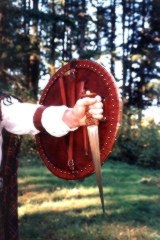
Arm holding dirk and targe. The dirk and targe in fighting position.
The Highlanders quietly waited the command to charge. In the center, carrying the Royal Stewart standard, was the Chief of the MacDonells of Glengarry. These Jacobite Highlanders were the product of a Celtic tribal culture where the warrior was the most admired individual. In ancient times the clan bards had sung of their heroes in this manner:
Beware of MacDonell! Beware of his wrath! In friendship or foray, oh cross not his path! He knoweth no bounds to his love or his hate, And the wind of his Claymore is blasting as fate. Like the hill-cat who springs from her lair in the rock He leaps on the foe–there is death in the shock. And the birds of the air shall be gorged with their prey When the Chief of Glengarry comes down to the fray, With his war-cry, The Rock of the Raven
On this warm summer’s day, each Highlander had prepared himself for battle. The poor clansmen had few guns. Most were barefoot, and they had shed their heavy woolen great-kilts. They stood with their long shirttails whipping loose about their thighs.
On their left forearms were the round leather-covered shield called a targe. From its center jutted a ten inch steel spike, making even the shield an offensive weapon. In his left hand, which was thrust through the leather straps holding the targe, every man gripped a dirk. Its blade was long enough that four or five inches protruded below the edge of the targe.
In his right hand was the Highlander’s yard-long basket hilt broadsword. Even though the true claymore of the 1500’s was a huge two-handed sword, the Scot still called his basket hilt a claymore; and the cry “Claymore!” was the battle command for the closing charge.
Looking at this array, it was easy to see why the English and the Lowland Scot called the Highlander a savage and a barbarian. General Mackay had good reason to be nervous, although he outnumbered the clansmen almost two to one.
The Highlanders began to move down the slope. At 100 paces Mackay ordered “Fire.” The English volley swept the stoically advancing Highlanders, but they immediately received the command “Claymore!” While the English forces fumbled to reload their heavy muskets or to insert plug bayonets into the muzzles, the clansmen closed on the run, screaming their clan war cries. They came in low, pushing pikes and gun muzzles upward with the targe and slamming into the front rank with targe spike and dirk. With the right hand they used the claymore against the second rank of English, stabbing and slashing.
In thirty minutes the Battle of Killiecrankie was over. Some 3800-4000 English troops lay dead on the field, along with about 800 Highlanders.
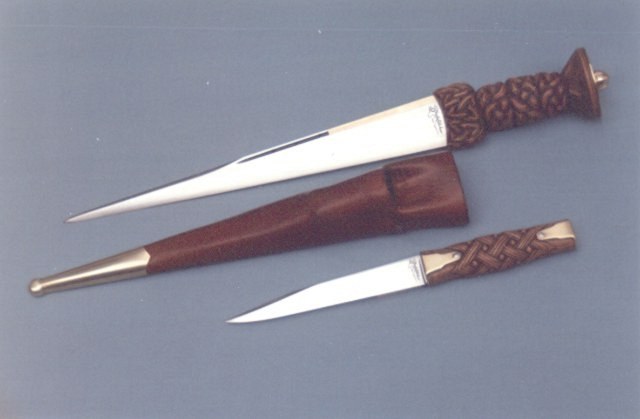
Dirk, sheath and single by-knife shown separately. This early dirk style was made from 1650-1700.
In all the rich variety of the world of knives, few are as distinctive as the Scottish Dirk. In its current form, the dirk is a massive piece of male jewelry, mounted in gold or silver, capped with semi-precious stones and worn with the kilt as part of formal evening dress. Like the Scot who wears it, however, the dirk had both humble and violent beginnings.
The first true dirks appeared in the early 1600’s, evolving from the medieval ballock dagger. The ballock dagger was a stabbing weapon, designed to pierce armor, with a heavy, sharply-pointed blade and a handle in the form of an erect penis with the testicles forming the ballocks, protective bulges between the handle and blade. In polite company, these were sometimes called kidney daggers.
The first Scottish Dirks retained the ballocks between the handle and blade but developed a wide, flaring pommel capped by a circular brass disk. The handle was carved of ivy root or boxwood root, usually cylindrical in shape, with grooves or one or two bands of Celtic knotwork carved around it. The blade was 12-13 inches long, thick, heavy and triangular in both profile and cross-section. Visitors to the Highlands during this period commented on how thick the dirk blades were and how sharp the single edge was kept. Quickly, the entire surface of the handle began to be richly carved with deep Celtic interlace patterns.
At first glance the large, flaring, disk-topped pommel looks awkward; but it served a purpose. When carrying the targe and dirk, the flared pommel helped prevent the dirk from being knocked from the clansman’s hand in the shock of combat, when the targe was receiving blows. Under these circumstances, the shape of the pommel made sense.
This early dirk, made throughout the 1600’s, was carried in a leather sheath, usually worn in the front center, with the point dangling between the legs. It frequently had a single “by-knife,” or utility knife with a five or six inch blade, carried in a pocket on the outside of the sheath. Along with a spoon, the by-knife was the Highlander’s primary eating utensil. Forks did not come into common usage until the late 1600’s.
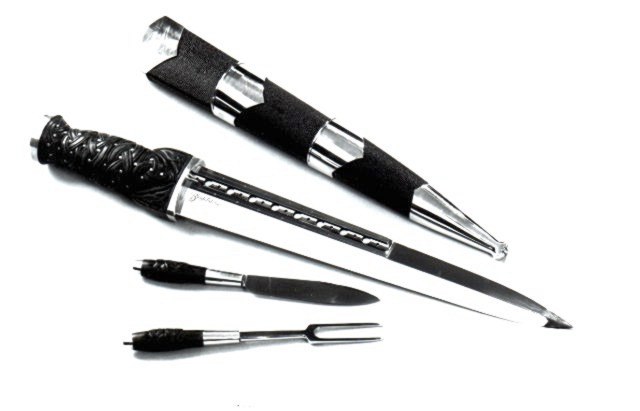
Brass-mounted dirk, sheath, and by-knife & fork. The dirk as made in 1740-1800. Typical of those used in the American Revolution.
The tactics used in the battle described above worked well, even against great odds, until the fateful Battle of Culloden in 1746. There Bonnie Prince Charlie mismanaged the Highlanders; and the clans were shattered, along with Scotland’s hope for independence.
In the meantime, the dirk continued to evolve. It became the equivalent of the American Bowie Knife, what today we would call a camp knife. Firearms made body armor obsolete so there was no longer any need for the heavy, sharply-tapered point. By 1700 a broader but thinner spear point, more suited for general-purpose cutting, became the norm. The single by-knife was reduced in size to around a four inch blade, and a matching two tined fork was incorporated into the sheath. Initially this eating knife and fork were mounted side-by-side in the sheath, with their handles just below the handle of the dirk. Later, however, the eating knife and fork were moved one above the other on the outside of the dirk sheath.
The form of the dirk also changed. The thinner blade allowed dirks to now be made from ground-down sword blades, which meant that for the first time the average dirk blade had one or more fullers, the grooves sometimes called “blood grooves.” The ballocks lost their bulbous character and became gently tapered haunches. The handle lost its cylindrical form and became more curved and hand-filling. It was still deeply carved with knotwork; but the large disk pommel cap was slowly reduced in size and began to be formed over the edges of the wooden pommel, better protecting its edge from damage.
The Highland clans had been broken at Culloden in 1746. All weapons had been forbidden to the Highlanders, and even the bagpipes were classed as a weapon of war. To be caught wearing a kilt or tartan in any form brought a harsh and automatic sentence. However, the English bowed to the obvious–the Scots were a tough, combative people and good fighters. The dirk, kilt and targe lived on in the Highland regiments which began to be formed in the English Army. One regiment which rapidly became famous was the Black Watch, which fought successfully in America during the French and Indian War of the 1750’s.
In the American colonies, Scots (and dirks) were in plentiful supply. During the Revolutionary War, they fought in large numbers for both sides. By now the form of the dirk had stabilized. It had a single-edge, spear-point blade 10 « to 13 inches long and a knotwork-carved handle, sometimes with decorative metal pins carefully placed in the interlacing of the carving. The thin brass disk on the pommel had developed into a full pommel cap, still circular in design; but since the targe was no longer used, it was now reduced to a proportion more in keeping with the size of the handle. To properly support the by-knife and fork, now mounted one above the other, the sheath was reinforced with a wooden lining.
In 1782 the English proscription against Highland weapons and dress was repealed. In the early 1800’s, Sir Walter Scott’s novels, such as Ivanhoe, romanticized the age of chivalry. Being a Scot himself, Sir Walter wrote a series of novels based on the Highlander, in which he contrasted the simple code of honor of the Highlander with the political deviousness of the Lowland Scot and the English. By the dawn of the Victorian Age, he and other less well-known writers transformed the poverty-stricken Highland Clansman into a romantic figure in the same way the dime novelist transformed the American cowboy into a hero. Even today, males of the British royal family often wear kilts while in Scotland at Holyrood Palace or Balmoral Castle.
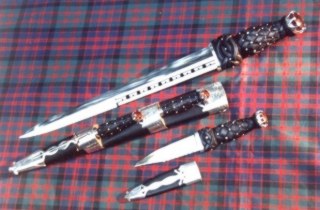
A classic Scottish dress dirk, as made from 1800 to the present, with its matching sgian dubh. This dirk was judged Best Art Knife at the 1995 OKCA Knife Show.
It was during this period that the dirk became an item of jewelry. Beginning about 1800, the dirk began a transformation. The blade retained its traditional size and shape, but the hilt began to assume some totally impractical forms. Some looked like three balls stacked one upon the other, others took an extreme thistle shape, with the handle at the base of the pommel ridiculously small in diameter. Others retained more traditional and practical shapes. However, almost all began to be highly decorated. The bold knotwork carving degenerated into a shallow basket weave pattern, with the emphasis now on the large metal pins at the corners of each panel. Pommels remained large and became highly decorated with engraving and/or three dimensional castings. Some were hollow to hold snuff; and many began to be mounted with agates or “cairn” stones, smoky quartz or citrines from the Cairn Mountains of Scotland. They were no longer made only by clan smiths in the Highlands, but by prominent cutlers in Edinburgh and Glasgow, and ultimately by famous names in England such as Wilkinson Sword.
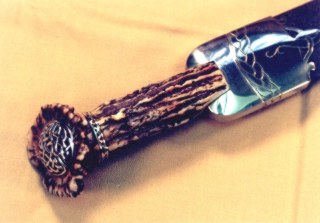
Brass mounted, antler handled dirks are for informal day wear. They usually have no by-knife or fork, but do have some form of pommel decoration.
As the Scottish revival grew, some of the ostentatious wealth that had Britons building replica 1400’s castles in the Highlands and huge country manor houses in England began to be applied to the dirk. Most were mounted in coin or sterling silver, and some in gold. Handles were now carved from ebony or ivory; and although the carving had lost its vitality, it was still studded with gold or silver pins. Semi-precious stones, citrine or amethyst, were in the pommels of dirk, knife and fork. To show off the stones to better advantage, they began to be tilted outward. For those who could not afford real stones, fakes were made of colored glass or cut crystal backed by various colored metal foils. Toward the end of the romantic period, from 1890 until the First World War, some dirks had the entire handle formed from a single faceted citrine crystal; and the mounts and sheaths were solid silver.
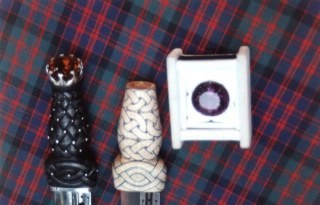
A handle mounting a 102 ct. Madiera citrine, an unfinished handle with pin holes bored and pattern ready to carve, and an unmounted 131 ct. amethyst.
A businessman dressed in a kilt in Edinburgh today is wearing much the same suit of clothing that was worn in 1700. The dirk is still made and worn, along with the sgian dubh, or stocking knife. However, now it seems to be of two classes. One is sold in Scottish shops for prices ranging from $200-$800. The cheapest of these have handles and stones cast in plastic, and the mounts are pewter castings plated with nickel or gold. The better ones are rather plain, usually without by-knife or fork. The mounts are undecorated sheet sterling silver, and the handles are blackwood carved in non-traditional floral patterns by craftsmen in India. The pommel stones are often paste.
The other class of modern dirk is crafted by a custom maker. They are almost never seen in stores, even in Scotland. They offer a wide variety of styles, but even the cheapest is expensive. Depending on the complexity of the pattern, the layout and carving of the handle can take one to four days; and even the making, polishing and installation of the pins in the carving can take a day.
This is multiplied by the fact that there are usually four components: dirk, by- knife and fork, and a complex wood lined sheath. Frequently there are six components, when the sgian dubh and its sheath are added, which are often ordered “en suite” with the dirk. The entire set invariably becomes a family heirloom, and is rarely resold.
A great deal of work goes into shaping and engraving the mounts, whether of brass or sterling silver. If stones are desired, the costs go even higher. A faceted round citrine or amethyst 1 1/8 inch in diameter, about minimum for a dirk pommel, will run about 100 carats, and one of average size, about 1 3/8 inches, will weigh 130 carats. Depending on the quality, these stones will cost from 9 to 15 dollars per carat, and they are hard to find in these large round shapes.
Like the kilt, the dirk is unique in western culture. Although it comes in an infinite variety, it has always been instantly recognizable as a Scottish Dirk. It differs from other large sheath knives in that it has been in continuous use and wear since the early 1600’s. After all, where else in western society is it considered high fashion to stroll into a formal dinner dance wearing a knife with a 13 inch blade?
AUTHOR’S NOTE: The targe and all knives made by Joe D. Huddleston, BladeCatcher Knives, 14129 93rd Ave. SE, Yelm, WA 98597-9707, (360) 458-2361. Part-time maker who will make knives full time on retirement from his “day job” in 1997. Specializes in Celtic and Scottish dirks and daggers. A member of Clan Donald USA, Huddleston is descended from the MacDonells of Glengarry and wears their kilt at knife shows and highland games. Prices of knives illustrated, $650 to $4500. Photos by Huddleston, the best that back patio camera work and drugstore processing can produce. Email address : Nhudd@aol.com
This article originally appeared in The Highlander magazine / (800) 607-4410
Copyright (C) 1999 Oregon Knife Collectors Association. No part of this article may be reproduced without permission of the OKCA.
